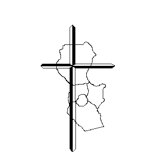Our Order
Our Vicariate
Our Way of Life
Our Familiy
Our Founder

The beginning of the thirteenth century was a time of renewed vigor for Europe: commerce revived; towns rose up; shining cities like Paris and London and Bologna grew in size, power and influence. Parliamentary democracy was here and there coming into being. A new learning was at work, with the ideas of pagan Aristotle and his Arab commentators beginning to fascinate the mind of the West.
But in the midst of this new life was also ecclesiastical corruption, despite the efforts of reformers like Innocent III. The new middle class of the cities, skeptical, increasingly educated, materialistic, could not be helped by a clergy that was generally untrained, nor by monastic foundations that were largely rural and, by definition, isolated from the currents of daily life. There was, in the words of Amos the Prophet, “a famine of the hearing of the Word of God” (Amos 8:11), and the vacuum was frequently filled by superstition, divisive heresy, and a love for this world. Various attempts were made to respond to the situation. Groups of diocesan priests living in community, the canons, engaged in parochial and theological work. In a number of places, lay preachers like the poor men of Lyons attempted to return to the simplicity of the early Church and to the Gospel-fervor of its early preachers. But most such lay groups quickly sank into doctrinal error, and had, in the end, to be suppressed.

It was in such a world that Dominic Guzman grew up, the son of a Spanish noble, who as a philosophy student sold his books to buy food for the starving, and for ten years served as a canon of the Cathedral at Osma in Spain. Dominic and his bishop, Diego, passed through southern France on a journey about 1204, and the journey changed their lives. The church was devastated in the region. Manichees, Cathari, Albigensians—the movement had various names—had propagated a doctrine that included a hatred for matter, for material sacraments as well as for the body itself. These were the products of an evil unspirited god.
Perfect religion was to starve oneself into the release of death. In contrast to worldly Catholic clergy, the leaders of the Cathari were rigid ascetics who captured the hearts of their followers by showing an example of a
life lived for a larger goal than one’s belly or one’s pocketbook, however extreme their actual beliefs were.
Dominic and Diego were moved at the state of the Church, and struck by the failure of past attempts to bring back the lapsed—past attempts by ecclesiastical dignitaries weighed down with servants and pomp. Dominic saw the need for preachers who would be learned, disciplined, and poor. With the approval of the bishop of Toulouse, Folques (who had once been a troubadour), Dominic began to gather a group of men willing to take up mendicancy and the dangers of preaching in hostile territory. They would sing a love song, but not that of the troubadours. They would sing the love of Jesus crucified. They would be given over to liturgical life and prayer, like the monks. They would be given over to active ministry in community, like the canons. But they would move about according to the needs of the Church and they would preach, something heretofore largely reserved to bishops. As he gathered his preachers, Dominic also established a convent of nuns (mostly converts from heresy), whose example and prayer would lend support to the campaign of the preachers.
Pope Honorius III granted universal approbation to the plan of life of the preachers in December 1216. The Friars, up to that time a promising experiment in southern France, were now given wider scope, directly under the patronage of the Holy See. And in 1217 Dominic took decisive action to ensure that the work of the Order would range as widely as the need for preachers did. After long prayer, he called his sixteen new followers together and dispersed them, despite their objections. They were too inexperienced, needed a leader, the Order was just getting on its feet, with few resources and few friends. Dominic’s reply: “Seed that is hoarded rots. You shall no longer live together in this house.”


So he sent them off: four to Spain, seven to Paris, two to stay on in Toulouse, two to Prouille. He and one last brother shortly went off to Rome. The seed was being scattered for harvest.
By 1221, the year of Dominic’s death, some 500 friars had spread as far as Hungary, Denmark, and England. By 1222 they had reached the mission fields of Cracow, Danzig, and Prague. Soon after, they were preaching the Word in Greece and Palestine. The story of the Preachers had begun.
All images on this page are from stained glass windows at St. Dominic’s Church, Washington, DC (Photographs by Fr. Lawrence Lew, O.P.)
